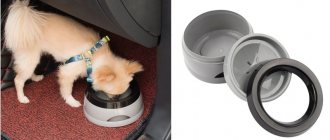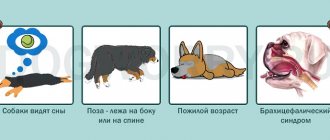When you love your dog, you want to take him with you wherever you go. Even if it means driving.
While many dogs look forward to riding in the car, others dread the experience and whine, drool, or even vomit.
This could be due to motion sickness, a previous bad event in a car such as an accident, or the fear of being trapped inside a giant moving machine.
The dog may even be put off on a car trip if the usual destination is an unpleasant place, such as a veterinarian.
If your dog is unhappy in the car, it can make everyone else unhappy too. Teach your dog to ride calmly and comfortably in the car so that your traveling companion becomes a first-class passenger.
When there's no time to explain
These tips are suitable for situations where you have the opportunity to spend a day/week/month getting your dog used to a new car. But it also happens that you urgently need to go somewhere in an unfamiliar car - for example, in a taxi or in a friends car. In this case, the safest and most gentle option for the dog is, again, a car carrier. Thanks to it, your pet will have a familiar place, regardless of what car he is in.
How to train your dog to travel by car
A car is an indispensable attribute of our life, and even if you don’t have your own, then sooner or later you will have to use a vehicle to travel to exhibitions or to veterinarians. No matter how strange and ordinary it sounds, the secret of training a dog to be transported is simple: only gradualism, repetition and encouragement of the dog will give you a good result.
If the family has its own car, then start accustoming the puppy to traveling in it as early as possible. No violence or unpleasant influences on the dog are acceptable. At first, you may have to lure it there with a treat, or it will follow the owner there, in any case, pet, praise the dog and encourage it with gentle words. To accustom a dog to a calm state when traveling, you can ride with a large breed dog together in the back seat at the very beginning of training; you can take a small breed dog in your arms. The bedding for the dog should be familiar and comfortable. It is better the dog not right before the trip, but do not forget that during the trip the dog can quickly get hungry, from strong impressions and feel thirsty. Therefore, you should have the usual food in small quantities and be sure to have a water bowl into which you will pour water for dogs. for a puppy to go long distances with you , so stop more often, let the dog run, play and relax. Loud noise and periodic shaking on the road are an unusual impact on the dog and it can easily become stressed during a long trip. Keep an eye on the dog, especially a puppy or a dog being transported for the first time. At the first signs of anxiety, changes in behavior, increased breathing, dilated pupils, it is better to stop the car and then calmly drive on. Follow the rule of gradualness, increasing both the distance and duration of trips. And everything is very individual, each dog is unique and the dog’s reaction to transportation may be different from others. But only the owner can understand and feel well the dog’s moment of fatigue. If the dog continues to feel unwell during trips , it is possible to use anti-motion sickness medications, which are recommended for children and other sedatives. Many dogs really love riding in a car, because it ultimately promises them new sensations and new experiences. And they are happy to jump not only into the door of your car. but also the neighboring one. Be attentive to your pets. I wish you pleasant and relaxing travels with your pets !
A dog in a car is becoming an increasingly common occurrence. And since a dog’s body is individual, all dogs tolerate being transported in a car differently: some quickly go through the process of getting used to traveling, while others cannot cope with a long stay in a car while driving. .The following are recommendations for training a dog to stay in a car based on the book by KATIE BERMAN, BILL LANDESMAN
“Put your dog on a suitable leash and collar and have him stand next to you near the car. Give her the “sit-sit” command when the car door is closed. Then open the door slowly, requiring it to still obey the “sit-seat” command. Close the door, turn around and walk, she should walk next to you; when you make another turn around, go to the car again. If she runs ahead to get into the car, make circles over and over again until you are approaching the car again. When your dog obeys the “sit-sit” command, open the door and allow your dog to climb into the back seat by saying “walk.” Sit in the front seat and, holding the leash in your hands, give her the “sit-seat” command. Praise her by saying “good.” If your dog is overly excited, use only words for reward. Get out of the car, the dog must follow the command “near” and repeat the entire procedure again. When you open the door, let her in by saying “walk” and have her climb into the back seat, then give the “sit-seat” command. Now, holding your hand in front of the muzzle, get the dog to lie down, since you have already achieved control by giving him the commands “sit-stay” and “lie down”. Continue until the dog gets up with the word “walk”, and lies down with the word “lie down”. Work with your dog until you feel the dog is completely under control. Then you have to have someone sit in the driver's seat and put the dog in the back seat. First, make sure you have the dog under control while the engine is running but the car is not moving. Next, establish control over the dog while the car is moving. Work with the dog until the dog demonstrates to you that he can handle himself normally in a moving car for short trips at moderate speed. Make these trips more challenging by going longer distances. You must be in the passenger's seat and be ready to correct the dog's behavior in case of any violation. Eventually, you will end up switching places with your assistant and driving while he corrects your dog's behavior. The dog must see that control is effective regardless of who is driving and who is correcting its behavior. Then the desired moment will finally come when you are alone in the car with the dog sitting in the back seat. Drive back and forth in your driveway or with U-turns on your street. If your dog commits any violations, shout “ew, lie down.” If the dog does not obey, calmly but quickly stop the car and turn to the dog, applying correction by jerking the leash down and with the command “fu”. If the dog does not lie down, give him a new command, and if he does not listen to this command, make a correction for the “lie down” command and begin to alternate corrections with commands. Once you have gained control, let your dog know that you can drive away with complete control of the situation, even though you are alone in the car with him. Perseverance and consistency pay off in all situations. If you need to leave for a minute, don’t grab the dog and don’t jump with it, it’s better to give the command “stay down” and leave it in the car.”
I RECOMMEND WATCHING:
Articles on the topic
- Hotels offering accommodation with pets
- Planning a vacation with a pet
- How to properly organize air travel for a dog
- Traveling with a dog
- Transportation of animals within the Russian Federation.
- Preparation of documents for the export of animals.
- Transporting animals by plane
- Transporting animals by train
- Transportation of cats
- Transporting dogs in a car
How to stop your dog from being afraid to ride in a car
In most cases, the dog is afraid to ride in a car due to the fact that its vestibular apparatus is not adapted to it. To ensure that your pet is not afraid to ride in a car, accustom him to traveling gradually. Before you wean your dog off from being afraid, first take it into the car, pet it, play with it, and after some time let it out into the street. Do this for several days in a row. Then try to start the engine and, with the engine turned on, continue the same manipulations. After a few more days, try to make the first short trip (to the nearest park) which will not take more than 5-7 minutes. Walk the dog, play with it, and then come back. And so, gradually, increase the time your dog spends in the car with you. Remember that you can accustom an animal to a car only if it does not have any negative emotions associated with the car!
Place of the dog while driving in the car
In order for the dog to calmly endure a long trip, it is necessary for the dog to prepare a comfortable place. Sometimes the road to a vacation spot can take more than one day, for example, the road to the South can take up to three days, and to Lake Baikal – four days one way (with normal movement and a full night’s rest). And the larger your pet, the more space it needs in the car.
There should be enough space for the dog to lie quietly, stretch out its paws if necessary and change its position. Some dogs, like in our case, ride in the back seat of a car. There are three of us traveling in the car (me, my husband and the dog), so we have the back seat free.
It is possible to allocate space for the dog in the trunk of a station wagon, but at the same time you need to secure the things that are in the trunk so that when moving they do not fall on the dog and crush or injure it. To do this, you can use a dense mesh stretched between the walls of the car.
Some tourists use special spacious cages to transport the animal in the car - transportation.
Sometimes dog owners recommend securing the dog with a leash while driving, especially if the dog is too active in the car and there is a risk of jumping on the driver’s arms or legs. Under no circumstances should you do this! When fixing, or more correctly, tying a dog in a car with a leash, when the car moves suddenly, for example, when braking sharply or going around an obstacle, there is a possibility of suffocation or injury to the pet, which will simply hang on its own collar.
If the dog behaves restlessly in the car and tries to move around the cabin, it is better to transport it in a bag or container - transportation. Believe me, it will be calmer and safer for both you and your pet.
A dog accustomed to a car behaves absolutely calmly in it. And many dogs, as soon as the movement began, like experienced tourists, fall apart in their place and calmly doze, occasionally showing curiosity about where they are now.
Don’t forget, a dog can handle a long car journey more calmly if it constantly sees its owners. Just like a small child.
Dog and public transport
Before starting to get acquainted with the trips, you must first accustom the dog to a collar (harness), a short leash and muzzle, walking nearby on a leash, sitting and laying down.
In order for the dog to get used to city public transport and its features, first take regular walks along the streets along which buses, trolleybuses or trams move. Periodically visit stops at different times of the day: let the dog smell, hear the sounds of transport, see how it slows down, how doors open and close, passengers enter and exit. One of the best options is to visit the final control towers, where vehicles are parked with their engines turned off. Here you need to walk past standing buses, trolleybuses, trams; with the permission of the drivers, enter the salon with the dog and give it the opportunity to calmly familiarize itself with the situation inside; drive to the first stop (in an empty car), where you can get off calmly and without fuss.
During this, do not forget to reward the dog for calm behavior. The main thing is not to rush, do not be nervous and do not force the dog to do what is required. In the future, make test trips from regular stops, first using times when the transport is least crowded, and as the dog begins to get used to it, trips with a large number of passengers. Make the first trips short (one or two stops), then the time spent in transport needs to be increased.
Accustom your puppy to city transport from four months.
At least a day before you take your dog on public transport for the first time, visit a bus stop so that your dog can gradually get used to the noise and flow of people.
Visit public transport stops with your dog at different times of the day.
What rules will you have to follow when using public transport? During the trip, the dog must wear a collar (harness), a muzzle, and be kept on a short leash. You must enter and leave the salon with your dog through the rear doors. While driving, you must remain in the rear area, trying not to disturb passengers. Be especially careful when boarding, traveling and exiting, constantly monitor the situation, and think through the entire route in advance.
Sometimes trolleybuses and trams have problems with electrical equipment (slight electrification of the floor, etc.). Dogs, standing with their bare paws on the floor of the salon, feel this very well. If you notice that your dog is nervously moving its paws when entering the vehicle, refuse the trip.










